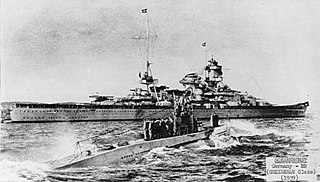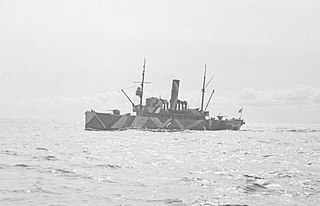The Kriegsmarine was the navy of Germany from 1935 to 1945. It superseded the Imperial German Navy of the German Empire (1871–1918) and the inter-war Reichsmarine (1919–1935) of the Weimar Republic. The Kriegsmarine was one of three official branches, along with the Heer and the Luftwaffe, of the Wehrmacht, the German armed forces from 1935 to 1945.

German submarine U-47 was a Type VIIB U-boat of Nazi Germany's Kriegsmarine during World War II. She was laid down on 25 February 1937 at Friedrich Krupp Germaniawerft in Kiel as yard number 582 and went into service on 17 December 1938 under the command of Günther Prien.

The Baltic Sea Campaigns were conducted by Axis and Allied naval forces in the Baltic Sea, its coastal regions, and the Gulf of Finland during World War II. After early fighting between Polish and German forces, the main combatants were Germany and Finland, opposed by the Soviet Union. Sweden's navy and merchant fleet played important roles, and the British Royal Navy planned Operation Catherine for the control of the Baltic Sea and its exit choke point into the North Sea.

Operation Berlin was a raid conducted by the two German Scharnhorst-class battleships against Allied shipping in the North Atlantic between 22 January and 22 March 1941. It formed part of the Battle of the Atlantic during World War II. The Scharnhorst and Gneisenau sailed from Germany, operated across the North Atlantic, sank or captured 22 Allied merchant vessels, and finished their mission by docking in occupied France. The British military sought to locate and attack the German battleships, but failed to damage them.

The Pinguin was a German auxiliary cruiser (Hilfskreuzer) which served as a commerce raider in World War II. The Pinguin was known to the Kriegsmarine as Schiff 33, and designated HSK 5. The most successful commerce raider of the war, she was known to the British Royal Navy as Raider F. The name Pinguin means penguin in German.

USS Callao (IX-205), an unclassified miscellaneous vessel, was the third ship of the United States Navy to be named for Callao, a seaport in Peru. She was built for the Kriegsmarine as the weather ship and icebreaker Externsteine. The ship was captured on 16 October 1944 by USCGC Eastwind of the Greenland Patrol and was temporarily commissioned into the United States Coast Guard as USCGC East Breeze before being turned over to the United States Navy and commissioned as USS Callao in January 1945. The ship was sold out of service in 1950, and broken up the following year.
German submarine U-30 was a Type VIIA U-boat of Nazi Germany's Kriegsmarine that served during World War II. She was ordered in April 1935 in violation of the Treaty of Versailles, which prevented the construction and commissioning of any U-boats for the German navy, and as part of the German naval rearmament program known as Plan Z. She sank the liner SS Athenia (1922) on 3 September 1939, under the command of Fritz-Julius Lemp. She was retired from front-line service in September 1940 after undertaking eight war patrols, having sunk 17 vessels and damaging two others. U-30 then served in a training role until the end of the war when she was scuttled. She was later raised and broken up for scrap in 1948.
Vorpostenboot, also referred to as VP-Boats, flakships or outpost boats, were German patrol boats which served during both World Wars. They were used around coastal areas and in coastal operations, and were tasked with – among other things – coastal patrol, ship escort, and naval combat.

Naval trawlers are vessels built along the lines of a fishing trawler but fitted out for naval purposes; they were widely used during the First and Second World Wars. Some—known in the Royal Navy as "Admiralty trawlers"— were purpose-built to naval specifications, others adapted from civilian use. Fishing trawlers were particularly suited for many naval requirements because they were robust vessels designed to work heavy trawls in all types of weather, and had large clear working decks. A minesweeper could be created by replacing the trawl with a mine sweep. Adding depth charge racks on the deck, ASDIC sonar below, and a 3-inch (76 mm) or 4-inch (102 mm) gun in the bow equipped the trawler for anti-submarine duties.
Operation Regenbogen was the code name for the planned mass scuttling of the German U-boat fleet, to avoid surrender, at the end of World War II.
German submarine U-804 was a Type IXC/40 U-boat of Nazi Germany's Kriegsmarine during World War II. U-804 was ordered on 7 December 1940, and was laid down on 1 December 1942 at Deutsche Schiff- und Maschinenbau AG Seebeckwerft, Bremerhaven as yard number 362. She was launched on 1 April 1943 and commissioned under the command of Oberleutnant zur See der Reserve Herbert Meyer on 4 December of that year.
Sachsenwald was a weather ship of Nazi Germany's Kriegsmarine during the Second World War. She was built in 1938/39 as a commercial trawler and operated out of Cuxhaven as PC318, but was requisitioned by the Kriegsmarine in January 1940 after being interned in Murmansk by Soviet authorities after the outbreak of war. Initially serving as a supply ship allocated to Basis Nord, Sachsenwald was intended for use in Operation Sea Lion before being converted for use as a weather ship under the designation Wetterbeobachtungsschiff 7.

Louhi was a Finnish Navy minelayer. The ship was originally constructed for the Imperial Russian Navy but was taken over by the Finns during the Russian Civil War. She had originally been named Voin, but was renamed as M1 in Finnish service. In 1936 she was given the more personal name Louhi, following the procedure of all other major ships in the Finnish navy.
HMCS Bras d'Or was an auxiliary minesweeper that served in the Royal Canadian Navy (RCN) between 1939 and 1940, when she sank with all hands in a storm. Previous to her service in the RCN, she served as Lightship No. 25 in the Canadian Department of Marine and Fisheries.
The action of 1 November 1944, also known as the Ambush off Pag Island, was a naval engagement in the Kvarner Gulf of the Adriatic Sea, between the islands of Pag and Lussino on 1 November 1944. It was fought between a British Royal Navy destroyer flotilla and a Kriegsmarine force of two corvettes and a destroyer. The German flotilla was deployed to escort a convoy retreating from Šibenik to Fiume. The British managed to destroy all three German ships in return for no loss.
Coburg was a fishing trawler that was built in 1938 and requisitioned by the Kriegsmarine in 1940. Converted to a weather ship, she became trapped in ice off the east coast of Greenland in October 1943 and was abandoned in June 1944.

SS Egerland was a oil tanker used by the German Navy in World War II. As the SS North America it was ordered from Deutsche Werft Finkenwerder for the Panama Transport Company as in July 1940, for transatlantic shipments to Germany. In March 1941, it was decided to transfer ownership to the Texas Oil Company. In 1941, the tanker was requisitioned by the Kriegsmarine, renamed to Egerland and converted to a support ship of the Trossschiffverband der Kriegsmarine for naval operations in the Atlantic. On the first mission in June 1941, to support commerce raiding by the German battleship Bismarck and the cruiser Prinz Eugen, the ship encountered the British heavy cruiser HMS London on 6 June and was scuttled to avoid capture.
V 801 Max Gundelach, originally designated PG-555, was a German fishing trawler which was converted into a Vorpostenboot patrol boat and placed in the 8th Picket Boat Flotilla during World War II.
V 1302 John Mahn was a fishing trawler requisitioned during World War II by the Kriegsmarine for use as a Vorpostenboot. It was launched in 1927 in Hamburg and was sunk in 1942 in the North Sea during Operation Cerberus.
Gauleiter Telschow was a German fishing trawler that was requisitioned by the Kriegsmarine in the Second World War for use as a Vorpostenboot, serving as V 206 Gauleiter Telschow and V 209 Gauleiter Telschow. She was torpedoed and sunk in the North Sea off Heligoland, Germany, France by HMS Sturgeon on 20 November 1939.







